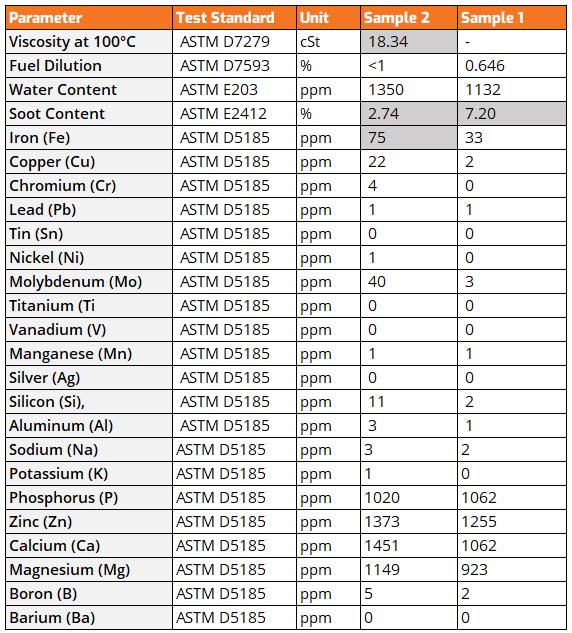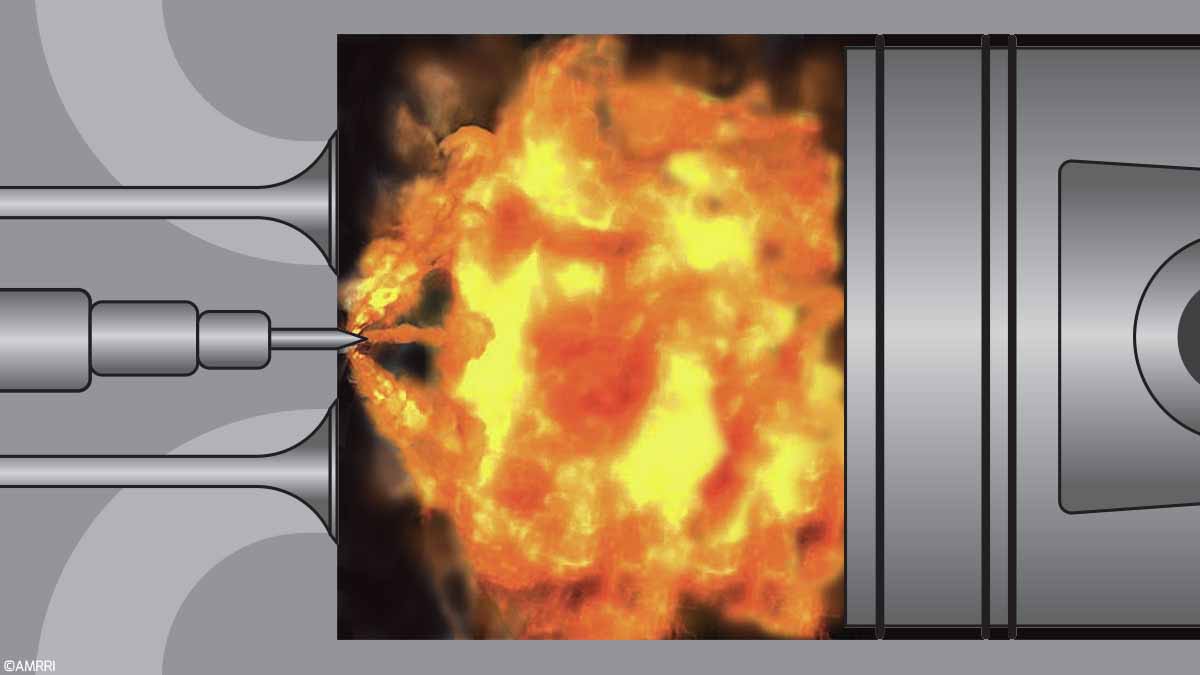Diesel engines are the driving force powering many modern transportation and industry applications. They can be found in vehicles and machinery, from trucks to marine vessels. In the port industry, diesel engines are found in Rubber Tire Gantry (RTG), Terminal Tractors, Reach Stackers, and other heavy mobile equipment.
Efficient engine function relies heavily on the combustion process that converts fuel into mechanical energy. High-quality combustion is crucial for optimal engine performance and overall reliability.
This article will not delve into the combustion reaction but into using engine oil analysis as a robust diagnosis and prognosis tool for monitoring combustion performance.
Oil Analysis: An Effective CBM Technique for Combustion Quality Monitoring
Oil analysis, as a CBM/PdM technique, is valuable for acquiring important information about the lubricant condition, wear, and contamination. It enables early failure detection, offering an opportunity for timely intervention.
Regular in-service engine oil analysis detects most of these issues as soon as they appear, often well before they become observable to the naked eye. With oil analysis data, maintenance managers or workshop supervisors can strategically plan interventions or conduct minor corrective maintenance actions instead of triggering a major intervention on the engine.
This article specifically addresses a singular aspect of engine oil contamination – namely, the suboptimal combustion by-products. Oil analysis is a valuable tool for identifying these by-products associated with poor combustion. It provides an opportunity to proactively address or mitigate the impact of:
Oil Degradation. Due to poor-quality combustion, the oil undergoes contamination from by-products of combustion or unburned fuel in the case of fuel dilution. These contaminants alter the physical and chemical characteristics of the oil and affect its performance properties.
Consequently, the oil fails to fulfill its lubrication and cooling functions. In the case of fuel dilution, the oil is thinned to the point where it cannot support the engine load or build a sufficient film to separate the moving parts. Additionally, poor combustion by-products act as catalysts for oxidation, enhancing oil degradation.
Engine Wear. Poor-quality combustion accelerates oil degradation. Therefore, the oil’s capacity to efficiently lubricate, cool, and protect the engine is diminished, increasing component stress and accelerating wear.
Decreased Engine Performance. Efficient combustion boosts the engine’s power output, providing better acceleration and overall performance. This efficiency ensures greater fuel conversion into usable energy, enhancing fuel efficiency. Conversely, poor combustion lowers fuel efficiency, increasing fuel consumption and operational expenses.
Safety Concerns. Fuel dilution lowers the oil’s flash point. When excessive fuel infiltrates the engine oil, it reduces the oil’s viscosity and increases its susceptibility to ignition. This presents a severe hazard, especially with the high engine temperatures.
Environment Pollution. Excessive soot emissions contribute to air pollution, as they contain harmful substances that can adversely affect air quality and human health. High-quality combustion reduces atmospheric emissions, contributing to environmental sustainability.
Tests Standards for Combustion Quality Monitoring
Two common indicators of incomplete combustion are fuel dilution and soot formation. There are many standards to help measure and monitor soot content and fuel dilution in in-service engine oils. Following are some essential tests for diesel engine combustion quality monitoring:
Soot Content
Soot, comprised of unburned combustion by-products, is found in oil as carbon, causing it to become thicker and darker.
Soot from diesel combustion is expected in an engine. No engine is 100 percent efficient. That’s why engine oil is doped with detergent/dispersant additives to enhance oil dispersancy.
Dispersancy is defined in ASTM D 7899 as the property that allows oil to suspend and carry away pollutants of diverse sources, such as soot from combustion, metallic particles from wear, corrosion of mechanical parts, and insoluble products resulting from the aging of the oil [1].
Excessive soot content signals potential issues with the components involved in combustion. These can be injection problems, prolonged oil drain intervals, low compression, high fuel/air ratio, and cold air temperatures.
Sometimes, elevated soot content is due to an excessive oil drain interval or operations practices like excessive idling.
Methods for testing soot in engine lubricating oil include:
- ASTM D7686, Standard Test Method for Field-Based Condition Monitoring of Soot in In-Service Lubricants Using a Fixed-Filter Infrared (IR) Instrument). This test method pertains to field-based monitoring of soot in diesel crankcase engine oils as well as in other types of engine oils where soot may contaminate the lubricant because of a blow-by due to incomplete combustion of fuels. It applies to oils having soot levels of up to 12% by mass [2].
- ASTM D7899, Standard Test Method for Measuring the Merit of Dispersancy of In-Service Engine Oils with Blotter Spot Method). This test method provides a simple technique for condition monitoring of the dispersancy property of in-service lubricants [1].
- ASTM D5967, Standard Test Method for Evaluation of Diesel Engine Oils in T-8 Diesel Engine, is a method for soot analysis by thermal gravimetric analysis.
- ASTM D7844-2 is the standard test method for condition monitoring of soot in in-service lubricants by trend analysis using Fourier Transform Infrared (FT-IR) spectrometry. This test method pertains to field-based monitoring of soot in diesel crankcase engine oils and other engine oils where soot may contaminate the lubricant because of a blow-by due to incomplete combustion of in-service fuels. This test method uses FT-IR spectroscopy to monitor soot buildup in in-service lubricants due to normal machinery operation. It is a fast, simple spectroscopic check for monitoring of soot in in-service lubricants to help diagnose the operational condition of the machine based on measuring the level of soot in the oil [3].
- ASTM E2412, Standard Practice for Condition Monitoring of In-Service Lubricants by Trend Analysis Using Fourier Transform Infrared (FT-IR) Spectrometry. This practice covers the use of FT-IR in monitoring additive depletion, contaminant buildup, and base stock degradation in machinery lubricants, hydraulic fluids, and other fluids used in regular machinery operation. Contaminants monitored include water, soot, ethylene glycol, fuels, and incorrect oil. Base stocks’ oxidation, nitration, and sulfonation are monitored as evidence of degradation [4].
These tests could directly confirm the presence of soot in engine oil, while other oil analysis tests play a contributing role in validating this issue. In this context, viscosity measured at 100°C for multigrade oils is a secondary test, as heightened soot content increases viscosity.
Additionally, elemental analysis can substantiate this degradation by evaluating the concentrations of wear metals resulting from inadequate lubrication as the oil undergoes degradation. Furthermore, as soot serves as an oxidation catalyst, oxidation levels and viscosity increase becomes apparent.
This confirms that oil analysis parameters are mutually complementary for a comprehensive and cohesive interpretation of oil analysis results.
Fuel Dilution
Fuel dilution occurs when the amount of unburned fuel in the engine oil increases. A high fuel dilution rate indicates an abnormal fuel passage into the oil. The predominant factor leading to fuel dilution involves infiltrating surplus fuel into the crankcase, which mixes with the engine oil.
With high fuel present in the oil, the lubricant’s viscosity becomes too low, reducing overall lubricating effectiveness. This phenomenon is often associated with raw or unburned fuel mixing with the oil resulting from incomplete combustion, worn injectors, or improper fuel/air ratio.
Sometimes, elevated fuel dilution could be due to operations like excessive idling.
The international standards to measure the amount of fuel present in oil include:
- ASTM D7593, Standard Test Method for Determination of Fuel Dilution for In-Service Engine Oils by Gas Chromatography.
- ASTM D 3524, Standard Test Method for Diesel Fuel Diluent in Used Diesel Engine Oils by Gas Chromatography. This test method uses gas chromatography to determine the amount of diesel fuel in used engine lubricating oil. It is limited to SAE 30 oil. The diesel fuel diluent is analyzed at concentrations up to 12 percent by mass. This test method may apply to higher viscosity grade oils. However, such oils were not included in the program used to develop the precision statement [5].
- ASTM E2412, Standard Practice for Condition Monitoring of In-Service Lubricants by Trend Analysis Using Fourier Transform Infrared (FT-IR) Spectrometry.
These tests confirm fuel dilution. Other oil analysis tests play a significant role in validating this issue. In this case, viscosity measured at 100°C for multigrade oils is a secondary test, as fuel dilution decreases viscosity. Likewise, reducing flash point serves as an additional means of confirming fuel dilution. Furthermore, a reduction in base number (BN) may indicate a significant fuel dilution.
Elemental analysis can also confirm this degradation by evaluating the concentrations of wear metals due to inadequate lubrication as the oil degrades. This analysis also provides helpful information about additive depletion.
Countermeasures for Poor Combustion Quality
Since poor combustion quality is connected with engine oil, to mitigate it, we should start by ensuring the fulfillment of the five’ rights’ of lubrication. First, we need to satisfy the Right Lubricant and Right Change Frequency. On the other hand, countermeasures to remedy poor quality involve supplying good fuel quality, checking air intake, and adjusting injection parameters. Consider these countermeasures:
- Lubricant Selection. Oils with low oxidation resistance tend to produce a precipitate more rapidly and in greater quantities than oil with high oxidation stability. Lubricants containing detergent and dispersant additives exhibit lower susceptibility to sedimentation because these additives enhance the capacity of the oil to retain insoluble impurities and resist oxidation more effectively. Make sure to use the appropriate lubricant and adhere to recommended oil specifications.
- Oil Change. A timely oil change is highly recommended. As detailed above, changing the oil as soon as possible is crucial, even for engines where soot contamination is detected without signs of wear. Soot can lead to complications over time.
- Air Filtration. A clogged or dirty filter can restrict airflow, affecting combustion. Inspect the air filter to ensure optimal combustion conditions.
- Fuel Quality. Fuel quality influences engine combustion. The heavier the fuel by fractional composition, the more it penetrates the crankcase. Adhere to recommended fuel specifications and use high-quality, clean fuel with the proper octane rating. This helps ensure a more efficient combustion process.
- Injection System Tune-up. Evaluate the air/fuel ratio and adjust the injection system to achieve a balanced mixture. Maintaining the correct air-fuel ratio is crucial for efficient combustion.
- Exhaust Monitoring: Monitor exhaust gases for evidence of incomplete combustion or unusual exhaust smoke. The presence of black smoke or a distinctive odor can indicate incomplete combustion.
- Operation Mode: The engine is most susceptible to inefficient combustion during light operation modes. These modes include minimal loads, low speeds, frequent and extended stops, and engine idling.
Case Study: Combustion Quality Monitoring for a Terminal Tractor Diesel Engine
Let’s explore a snippet from an engine oil analysis report of a terminal tractor with a cumulative operation time exceeding 110,000 Hours. During the criticality assessment, the terminal tractor diesel engine was identified as critical equipment.
An oil sample is drawn from this diesel engine every 500 running hours. The routine analysis slate includes the following parameters: Viscosity at 100°C, Base Number (BN), Water Content, Elemental Analysis, Fuel Dilution, Oxidation, Nitration, Sulfation, Glycol Content, and Soot Content.
Two oil analysis reports have been released so far. Given the focus on engine combustion efficiency in this case study, our attention in this oil analysis report will be directed towards associated with the monitoring of combustion quality, with a primary emphasis on Fuel Dilution and soot as primary tests for the engine combustion quality monitoring.
Additionally, viscosity and wear are serving as complementary tests. The table below provides a summary of these findings:

Analyzed by Gas Chromatography in accordance with ASTM D7593, the measurement of fuel dilution in both samples confirmed acceptable values, remaining below 2% by weight.
On the other hand, soot content in the first sample exceeded the acceptable range of 2 % by weight. However, no consequential increase in wear metals was observed, as their concentrations remain within acceptable limits.
In the second sample, there is a moderate concentration of iron, elevated Soot content, and high oil viscosity. These findings suggest a rich fuel mixture, generating soot that is highly abrasive and consequently contributing to engine wear.
The maintenance team has been advised to check the control points mentioned in the Countermeasures for Poor Combustion Quality section above. The feedback received confirms the satisfactory status of the requested inspections. This leads us to conclude that the elevated soot levels are primarily due to the extensive unit service time (+100,000 hours) and prolonged use of oil (+500 Hours).
According to the OEM, the oil should be replaced every 250 Hours. A subsequent sample will be drawn for condition monitoring and trending at the next scheduled interval. We expect to observe a notable reduction in soot levels and an overall enhancement in engine health.
References
[1] ASTM D7899-13: Standard Test Method for Measuring the Merit of Dispersancy of In-Service Engine Oils with Blotter Spot Method.
[2] ASTM D7686-19, Standard Test Method for Field-Based Condition Monitoring of Soot in In-Service Lubricants Using a Fixed-Filter Infrared (IR) Instrument).
[3] ASTM D7844-21 Standard Test Method for Condition Monitoring of Soot in In-Service Lubricants by Trend Analysis using Fourier Transform Infrared (FT-IR) Spectrometry.
[4] ASTM E2412-23 Standard Practice for Condition Monitoring of In-Service Lubricants by Trend Analysis Using Fourier Transform Infrared (FT-IR) Spectrometry.
[5] ASTM D 3524-14 (2020): Standard Test Method for Diesel Fuel Diluent in Used Diesel Engine Oils by Gas Chromatography.









